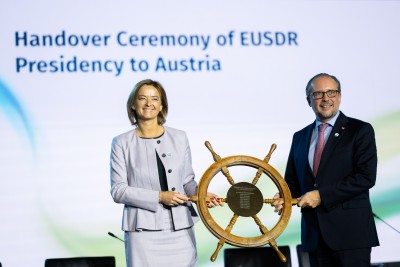Austria Takes Over Chairmanship of the EU Strategy for the Danube Region
November 1, 2023, marks the beginning of an important phase for Austria as it takes over the presidency of the EU Strategy for the Danube Region (EUSDR). This key region, which stretches from the Black Forest to the Black Sea and encompasses around 115 million people, faces a multitude of challenges. The country is taking over this task from Slovenia and will be in charge until December 31, 2024.
 Austrian Foreign Minister Alexander Schallenberg attended the annual EU Strategy for the Danube Region forum in Brdo, Slovenia, where Slovenian Foreign Minister Tanja Fajon handed over the chair. / Picture: © BMEIA Bundesministerium für Europa, Integration und Äußeres / Gruber / Flickr Attribution 2.0 Generic (CC BY 2.0)
Austrian Foreign Minister Alexander Schallenberg attended the annual EU Strategy for the Danube Region forum in Brdo, Slovenia, where Slovenian Foreign Minister Tanja Fajon handed over the chair. / Picture: © BMEIA Bundesministerium für Europa, Integration und Äußeres / Gruber / Flickr Attribution 2.0 Generic (CC BY 2.0)
The Danube Region, which comprises fourteen states, including nine EU Member States and five candidate countries, is a region of cooperation and solidarity. "Shaping Transformation, Creating Opportunities: A Prosperous, Resilient and Secure Danube Region" is the motto under which Austria will preside. This initiative aims to strengthen regional cooperation and create new opportunities in times of uncertainty.
The region is facing several challenges, including Russia's war of aggression against Ukraine, a member of the EUSDR, in violation of international law, demographic and economic difficulties, and the effects of climate change. Austria's goal during its Chairmanship is to respond to these challenges and strengthen the region.
Austria's substantive priorities during its Chairmanship include ensuring security and stability throughout the Danube Region, promoting innovation, skills development, and competitiveness, as well as improving the river ecosystem and greening water management.
Austria's commitment to involving civil society and youth is particularly noteworthy. "The Austrian chairmanship enables us increasingly to intensify and advance the work of the Danube Region Strategy and also to make the added value of cooperation in the Danube Region tangible to a certain extent," emphasizes Austria's Federal Minister for Agriculture Norbert Totschnig.
The EUSDR, which was founded in 2011 on the initiative of Austria and Romania, is a cross-border initiative for territorial cooperation and regional development. The strategic framework is complemented by the INTERREG program for the Danube Region. Austria plays a central role in this strategy and has always been committed to close cooperation between the countries of the region.
Guidepost for regional cooperation and prosperity
The EU Strategy for the Danube Region (EUSDR), is an ambitious European program that aims to create greater prosperity for some 115 million people in a region of about 800,000 km² through closer relations and cooperation. This region spans fourteen countries, including nine EU member states and five non-EU member states, from Austria to the Black Sea.
Austria has played a leading role in promoting cooperation between the countries of the Danube region in the past and, together with Romania, took the initiative to create the EUSDR. The strategy was presented by the European Commission on December 8, 2010, and endorsed by the European Council on June 24, 2011. Under the motto "Prosperity through Diversity," the EUSDR is committed to connecting the region, protecting the environment, building prosperity, and strengthening the Danube Region.
The EUSDR focuses on four central pillars, which in turn are divided into twelve priority areas. Austria is coordinating in three of these areas, namely improving mobility and inland waterways, investing in people and skills, and improving institutional capacity and cooperation.
The four pillars of the EUSDR include:
1. networking the Danube Region: this involves improving mobility, promoting sustainable energy, and strengthening culture, tourism, and people-to-people contact.
2. environmental protection in the Danube Region: this area deals with the restoration and safeguarding of water quality, the management of environmental risks, and the preservation of biodiversity and the quality of air and soil.
3. building prosperity in the Danube Region: this area focuses on the development of the knowledge society through research, education, and information technologies, the promotion of business competitiveness, and investment in people and skills.
4. strengthening the Danube Region: this pillar focuses on improving institutional capacity and cooperation and strengthening security in the region.
The EUSDR is not the only macro-regional strategy of the European Union; there are three others, namely the EU Alpine Space Strategy, the EU Baltic Sea Strategy, and the EU Strategy for the Adriatic and Ionian Region. Domestically, the Federal Ministry for Europe, Integration and Foreign Affairs and the Federal Ministry for Agriculture, Regions and Tourism are responsible for implementing the strategy.
The new Action Plan presented by the European Commission in 2020 represents a further step towards the strategic goals of the EUSDR, with 85 concrete actions to implement the strategy. With Ukraine as chair in 2022, followed by Slovenia, and a secretariat in Vienna and Bucharest, the EUSDR continues on its path to connect, protect, strengthen, and create prosperity for the Danube Region's inhabitants.



